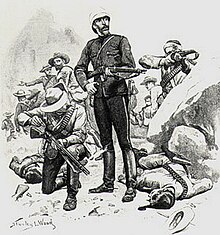Rearguard

Arearguardorrear securityis a part of amilitaryforce that protects it from attack from the rear, either during an advance orwithdrawal.The term can also be used to describe forces protecting lines, such ascommunication lines,behind an army.[1]Even more generally, a rearguard action may referidiomaticallyto an attempt at preventing something though it is likely too late to be prevented; this idiomatic meaning may apply in either a military or non-military context.[2]
Origins
[edit]The term rearguard (alsorereward,rearward) comes from theOld Frenchreregarde,[3]i.e. "the guard which is behind", originating with the medieval custom of dividing an army into threebattlesorwards;Van,Main (or Middle) and Rear.[4]The Rear Ward usually followed the other wards on the march and during a battle usually formed the rearmost of the three if deployed incolumnor the left-hand ward if deployed inline.
Original usage
[edit]
The commonly accepted definition of a rearguard in military tactics was largely established in the battles of the late 19th century. Before the mechanization of troop formations, most rearguard tactics originally contemplated the use ofcavalryforces.[5]This definition was later extended to highly mobile infantry as well as mechanized or armored forces.
Narrowly defined, a rearguard is a covering detachment that protects the retreating main ground force element (main body), or column, and is charged with executing defensive or retrograde movements between the main body and the enemy to prevent the latter from attacking or interfering with the movement of the main body.[6][7]
Contemporary usage
[edit]
A more expansive definition of the rearguard arose during the large-scale struggles between nation-states duringWorld War IandWorld War II.In this context, a rearguard can be a minor unit of regular or irregular troops that protect the withdrawal of larger numbers of personnel (military or civilian) during a retreat, by blocking, defending, delaying, or otherwise interfering with enemy forces in order to gain time for the remainder to regroup or reorganize. Rearguard actions may be undertaken in a number of ways: defensively, such as by defending strongpoints or tactically important terrain; or offensively, by pre-emptively assaulting with aspoiling attackan enemy that is preparing offensive operations.[8]
Three examples of rearguard actions are:
- Rorke's Driftduring theZulu War(1879)[9]
- Battle of Tirad Pass(1899)
- Battle of Dunkirk(1940)[9]
AWorld War I-era example is the rearguard action fought by small units of theSerbian Armyto protect retreating Serbian troops, theroyal family,and Serbian refugees from advancing forces of theCentral Powersduring theirretreat through Albania and Montenegroin 1915–1916.[10][11][12]The nature of combat in rearguard actions involving combat between armies of nation-states is typically desperate and vicious, and rearguard troops may be called upon to incur heavy casualties or even to sacrifice all of their combat strength and personnel for the benefit of the withdrawing forces.[13][14]
Idiomatic expression
[edit]Fighting or mounting a rearguard action is also sometimes anidiomaticexpression, outside any military context. That idiom refers to trying very hard to prevent a thing from happening even though it is probably too late.[2]An example of a famous rearguard action outside the military context is the effort by Roman emperorJulianaround 362 A.D. to restorePaganismas the state religion instead of Christianity.[15]Sportswriters employ the idiom as well.[9][16]
See also
[edit]References
[edit]- ^Oxford English Dictionary:
- rearguard n.1.b: A body of troops detached from the main force to bring up and protect the rear, esp. in the case of a retreat. Also fig. and in extended use. "
- "rear guard, n.2: Chiefly Brit. The guard at the rear of a railway train."
- ^abCambridge Idioms Dictionary(2nd ed., Cambridge University Press, 2006) viaThe Free Dictionary.
- ^Murray, James A. H.; Bradley, Henry; Craigie, W. A.; Onions, C. T., eds. (1933).The Oxford English Dictionary (vol. 8)(1st ed.). Oxford: Clarendon Press.
{{cite book}}:Unknown parameter|agency=ignored (help) - ^Rogers, Clifford(2007).Soldiers Lives through History: The Middle Ages.Westport: Greenwood. p. 73.ISBN978-0-313-33350-7.
- ^Burnham, W.P. (Lt.)Manual of Guard Duty, U.S. Army,Syracuse, New York: C.P. Bardeen, Publisher (1893) pp. 92–95
- ^Bond, Paul Stanley (Lt. Col.) and Crouch, Edwin Hunter (1st Lt.), New York: The American Army and Navy Journal (1922)Tactics: the practical art of leading troops in war,pp. 247–253
- ^Headquarters, Dept. of the Army,5-166: Spoiling Attack,Army Field Manual FM 3-90 (Tactics) (July 2001), p. 12-25
- ^Headquarters, Dept. of the Army,5-166: Spoiling Attack,Army Field Manual FM 3-90 (Tactics) (July 2001), pp. 5–39, 5–40: A spoiling attack is a defensive attack, undertaken to preempt or seriously impair an expected enemy assault by attacking the enemy while the latter is in the process of assembly or preparation for offensive operations.
- ^abcCrowley, Liz and Hand, David.Football, Europe and the Press,p. 31 (Routledge 2013).
- ^Corey, Herbert,The Serbian Tragedy As I Saw It,Harper's Monthly Magazine (June 1917), p. 334
- ^Big Guns Blast Way in Serbia: Population Joins Retreat,The New York Times, 3 November 1915
- ^Frucht, Richard (ed.),Eastern Europe: an introduction to the people, lands, and culture,Vol. 3,ISBN1-57607-800-0(2005) p. 542: The Serbian rearguard actions allowed some 125,000–145,000 soldiers ofMarshal Putnik's Serbian Army together with several thousand civilian refugees to reach Adriatic ports in Albania, where they were eventually evacuated, reorganized, and reequipped for the campaign inSalonika.
- ^Sebag-Montefiore, Hugh,Dunkirk: Fight to the Last Man,(1st ed.), Cambridge, Massachusetts: Harvard University Press,ISBN978-0-674-02439-7(2006), p. 233
- ^Bimberg, Edward L.,World War II: A Tale of the French Foreign Legion,World War II Magazine (September 1997), p. 32: On 9 June 1940, the97th Foreign Legion Divisional Reconnaissance Group,equipped with light armored cars, made a spoiling attack against German armored forces equipped withPzkw Mk IIItanks in order to protect the withdrawal of French Forces. In two consecutive assaults, the unit lost all its armored cars, incurring heavy casualties.
- ^Corey, Melinda and Ochoa, George.Fitzroy Dearborn Chronology of Ideas: A Record of Philosophical, Political, Theological and Social Thought from Ancient Times to the Present,p. 47 (Routledge 2013).
- ^Reavis, Tracey.The Life and Career of David Beckham: Football Legend, Cultural Icon,p. 70 (Rowman & Littlefield, 2014).
